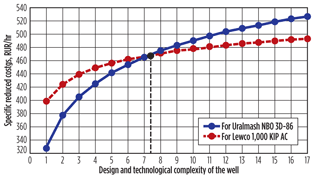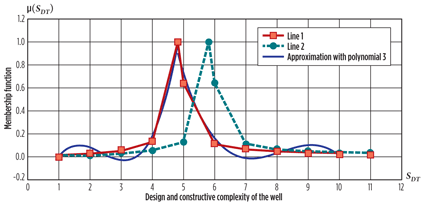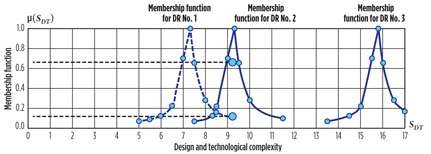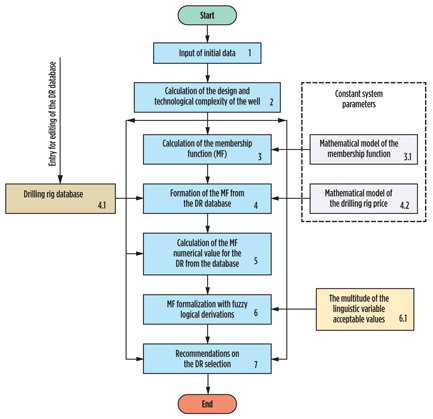Valeri A. Shmelev and Yuri P. Serdobintsev, Volgograd State Technical University
In selecting a drilling rig for the actual geological environment of well construction, a decision support system can reduce the cost per unit, construction time cycle and simplify the design complexity of the well.
Construction of oil wells can take place in different geological conditions. The world market of drilling equipment (DE) has lately been characterized by the environment of drilling rigs of a new type.1 Creation of an automated system for decision support when choosing a drilling rig (DR) for the specific geological conditions is an urgent research task in oil and gas production.
Taking into account its high cost, the numerous options for the substantiated choice of modern DE is of large significance. Many drilling contractors buy expensive equipment justifying the purchase by a reduction in current operation expenditures.2-4
The selection of a DR by the admissible load capacity and the operation requirements for the DR do not allow for an adequate assessment and comparison of the applicability of DRs of different types for various well constructions.
Complexity of vertical wells
The suggested approach to the DR selection is based on the introduced idea of the design and technological complexity of vertical wells. The approach implies the use of the identified dependence1 that takes into account the geological conditions of well construction having the form of an integrated parameter.
The design and technological complexity of a vertical well can be represented by multiplication of the design SD and technological ST complexity.
 Eq. 1 Eq. 1
 |
|
Fig. 1. Design of an oil well
|
|
The design complexity can be expressed in the quantity k of the main elements of the well design SDM (casing strings for well casing) and the quantity of additional elements SDA (liners), Fig. 1.
 Eq. 2 Eq. 2
where n and m – intervals of well casing by casing strings and liners, respectively; i and j – the order number of the casing interval.
The technological complexity can be expressed by the multiplication of the following factors:
 Eq. 3 Eq. 3
where ß1 is the technological complexity that takes into account the depth of the oil well; ß2 is the technological coefficient that takes into account the lithology of the oil well section.
The numerical definition of the ß1 and ß1 coefficients is based on the fundamental assumption that these coefficients are taken equalling one.
The arithmetical mean value of the well depth for the studied field is taken as the basic assumption. Thus, the relation of the total of mechanical drilling time rates by well intervals (the setting depth of each casing string is in Fig. 1) to the total of mechanical drilling time rates to the basic interval enables determining the numerical expression at different well depths.
 Eq. 4 Eq. 4
where n is the quantity of the well drilling intervals; m - the quantity of well drilling intervals corresponding to the depth of the basic interval; Tdrill.i is the mechanical drilling time of one meter of the i interval in the well.
Decision criteria
The following assumptions have been used to determine the ß2 coefficient: the geological section of exploration and prospect wells (determined by the results of the lithology and stratigraphy studies) can be used to identify several rock types possessing similar physical and mechanical properties and found to different extent in each section of an oil well. The total quantity of the found rock types depends on the lithological structure of the well section.5
The relationship between the total of mechanical drilling time rates for one meter for the identified geological rock types and the total of mechanical drilling time rates for one meter of the basic combination of rock types that corresponds to the arithmetic mean well depth in the field allows for identification of the dependence of ß2 coefficient on the geological section of the oil well using the regression analysis.
 Eq. 5 Eq. 5
where n - the quantity of the identified rock types; m - the basic combination of the rock types corresponding to the arithmetic mean depth of wells in the field; Tdrill.i - mechanical drilling time of one meter of the i geological type of rock types in the well section.
For example, in one study, the total quantity of the determined rock types is eight, and the basic quantity for the studied field was taken to be six as this is the most frequent combination at an arithmetical mean average well depth of 2,500 m.7
The mathematical model of the design and technological complexity of a vertical oil well has been obtained after the statistical analysis of the calculated data by ß1 and ß1 coefficients and using the regression analysis.
 Eq. 6 Eq. 6
where H is the well depth, m; R is the quantity of the found lithological rock types in the geological section of the well.
The task of the substantiated DR selection based on the determination of the design and technological complexity of the well SDT can be solved by using the criterion of minimum specific reduced cost for the construction of the well  at a given load capacity of the DR. at a given load capacity of the DR.
For the analysis of the change  , we can use the example (Eq. 7) that takes into account both the i drilling interval production cost Ci and the capital cost - the DR price. , we can use the example (Eq. 7) that takes into account both the i drilling interval production cost Ci and the capital cost - the DR price.
 Eq. 7 Eq. 7
where n - the number of drilling intervals, pcs; C – current expenditures (interval drilling cost), RUR; K - capital expenditures (DR price), RUR; N - drilling equipment depreciation rate, %; Tdrill – DR operation time while drilling, hour; Ty - DR operation time within a year, hour; Ks - well construction production cycle timing coefficient using the DR with various function structure (specified as per regulatory card of drilling production). The Ks coefficient considers the reduction of secondary operations duration (stripping and assembly of package-hole assembly, roundtrip operations, drilling mode changes and etc.).
The calculations of the reduced costs by the example of two Russian DR (Uralmash 3D-86) and an American “Lewco 1000kips AC” are given in several articles.8,9
The curve depicting the change of the specific reduced costs  depending on the design and technological complexity of the well SDT is given in Fig. 2. depending on the design and technological complexity of the well SDT is given in Fig. 2.
 |
|
Fig. 2. Specific reduced costs  vs. the design and technological complexity of the well SDT. vs. the design and technological complexity of the well SDT.
|
|
As a result of the analysis of the obtained dependence it is possible to identify the boundary of the cost-effective use of DRs with various function structures.
The following conclusion can be made: the multiple-function expensive DRs are effective for the construction of wells having high design and technological complexity. For wells with lower design and technological complexity it is economically feasible to use cheaper drilling rigs with less function structures.
System application
For implementation of the above described approach of the economic feasibility assessment of drilling rigs selection a decision support system has been created for selection of drilling rigs taking into account the integrated parameter – design and technological complexity of the well.
The structural scheme and the information links for the implementation of the automated decision making support system for the selection of DRs are given in Fig. 3.
.gif) |
|
Fig. 3. Structural scheme of the automated decision support system for the selection of DRs.
|
|
A database is created at the first stage of the development of the automated system. It includes the initial data required for the determination of the design and technological complexity of the well as the quantitative parameter of the geological conditions of well construction (blocks 1.1 and 1.2).
The automated system includes the creation of the drilling rigs database, creation of the membership function (MF) in accordance with the chosen criteria of the minimization of specific reduced costs, expert analysis of the membership function values and preparation of the results of the drilling rigs optimal use of for the specific geological conditions (blocks 2.1 – 2.5).
The distribution system for the specific reduced costs is offered to be formalized using fuzzy logic 6 that indicates to the creation of the membership function. It had been obtained on the basis of the determination of the dependence between the change of the difference between the specific reduced costs Δ and the design and technological complexity of the well SDT (Fig. 4). and the design and technological complexity of the well SDT (Fig. 4).
Figure 4 presents the curve depicting the change of the membership function
µ(SDT) depending on the design and technological complexity of the well SDT.
 |
|
Fig. 4. Membership function for the selection of the drilling rig.
|
|
The approximation of the above described dependence µ(SDT) using the MathCAD package allowed for obtaining of the calculated mathematical model for the construction of the MF:
 Eq. 8 Eq. 8
where ai and  are factors of polynomial model of the membership function; Thus, based on the membership function creation and its relative position with respect to the axis of the design and technological complexity (lines 1 and 2 in Fig. 4) for each of the DRs in the drilling contractor’s rig fleet, the feasibility of its usage depending on the design and technological complexity can be determined, Fig. 5. are factors of polynomial model of the membership function; Thus, based on the membership function creation and its relative position with respect to the axis of the design and technological complexity (lines 1 and 2 in Fig. 4) for each of the DRs in the drilling contractor’s rig fleet, the feasibility of its usage depending on the design and technological complexity can be determined, Fig. 5.
 |
|
Fig. 5. Feasibility of the DR usage depending on the design and technological complexity of the well.
|
|
Curve 1 corresponds to the price category for the National Oilwell Varco drilling rig; curve 2 – Bentec; curve 3 – Lewco 1000 Kips AC (according to Table 2 – recommendations on the selection of drilling rigs).
| Table 1. Values of the constructive parameters of the well that are initial data for the creation of an automated system. |
 |
| Table 2. Recommendations on the DR selection. (click to enlarge) |
 |
The algorithm for the automated decision support system that implements the operations for preparation of the recommendations on the selection of DRs in accordance with the criterion of minimum specific reduced costs is given in Figure 6.
At the initial stage (block 1) the input of the project well construction is performed. The design and technological complexity of the well is determined according to the dependence 6, block 2. The membership function is generated in block 3 based on the calculated model the formula.8 The automated system makes the choice from the DRs database and forms the membership functions for each of them in block 4 according to the developed DR selection methodology based on the minimum value of the specific reduced costs.
In block 5, the numerical value of the MFs is generated for the design and technological complexity corresponding to the geological conditions of the well construction.
The formalization of the MF (block 6) is explained by the necessity to present the results through term-multitudes as there are no membership functions for some values of SDT at the discrete change of DR prices. In this case the system chooses as optimum the DR having the price that provides minimum specific reduced costs.
In block 7 the results of the decision making on the use of the recommended DR in the specific geological conditions is formed on the basis of the minimization of the specific reduced costs at well construction.
 |
|
Fig. 6. The algorithm for the automated decision support system.
|
|
An example of the implementation of the decision support system when choosing drilling rigs considering the geological conditions of well construction.
Conclusion
Creation of a decision support system for selection of a drilling rig taking into account the geological conditions of well construction allows for solving the tasks of preparation for operation and tasks related to the reduction of cost and well construction production cycle time, and perform the loading of the available drilling rigs from the point of view of economic feasibility of their application in the specific geological conditions of well construction; perform timely and long-term planning of operations in accordance with the well drilling programme.
LITERATURE CITED
1 Berkman S. Строительство буровых установок, несмотря на снижение активности / S. Berkman, T. Stokes // Нефтегазовые технологии. – 2008. - № 2 – С. 52 - 60.
2 Отраслевая статистика // Нефтегазовые технологии. – 2010. - № 8 – С. 54 - 55.
3 New Rigs Designs: Skidding rigs for pad drill sites // World Oil - Vol. 228, №12. – R-93-95.2007.
4 Nabors Drilling International // Press release. - 2005 - 13 р.
5 Чижов С. И. Особенности геологического строения среднедевонских отложений Кудиновско-Романовской приподнятой зоны / С.И. Чижов, Н.В. Даньшина // Геология, геофизика и разработка нефтяных и газовых месторождений. – 2003. - № 10. – С. 26-29.
6 Заде Лофти. А. Понятие лингвистической переменной и его применение к принятию приближенных решений. – М.: Мир, 1976. - 165 с.
7 Шмелев В. А., Сердобинцев Ю. П. Часть I. Разработка математической модели конструктивно-технологической сложности вертикальной нефтяной скважины // Строительство нефтяных и газовых скважин на суше и на море. – 2010 - №2 – С. 3-8.
8 Шмелев В. А., Сердобинцев Ю. П. Часть II. Технико-экономическое обоснование выбора буровой установки для вертикальных нефтяных скважин // Строительство нефтяных и газовых скважин на суше и на море. – 2010. - №4 – С. 4-7.
9 Шмелев В. А. / Разработка математической модели определения приведенных затрат на бурение в зависимости от цены буровой установки и конструктивно-технологической сложности вертикальной нефтяной скважины // Вестник ассоциации буровых подрядчиков – 2010 - №1 – С. 13-15.
|


 Eq. 2
Eq. 2 Eq. 4
Eq. 4 Eq. 5
Eq. 5 Eq. 7
Eq. 7
.gif)

 Eq. 8
Eq. 8



